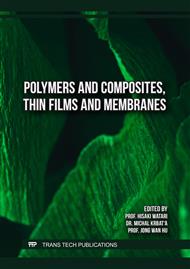[1]
D. S. Abolin'sh: Compliance tensor for an elastic material reinforced in one direction, Polym. Mech. No.4 (1965), pp.52-59.
Google Scholar
[2]
Z. Hashin and B. Rosen: The elastic moduli of fiber-reinforced materials, J. Appl. Mech. No.2 (1964), pp.223-232.
DOI: 10.1115/1.3629590
Google Scholar
[3]
R. G. Hill: Theory of mechanical properties of fibre-strengthened materials. I. Elastic behavior, J. Mech. Phys. Solids Vol.12, No.4 (1964), pp.199-212.
Google Scholar
[4]
G. A. Van Fo Fy: Structures of Reinforces Plastics [in Russian] (Kiev, Technika 1971).
Google Scholar
[5]
V. V. Bolotin: Planar problems of the theory of elasticity for parts made of reinforced materials. (Calculations of Strength [in Russian], M. Mashinostroenie, Vol. 12 1966), pp.3-31.
Google Scholar
[6]
Yu. M. Tarnopol'skii, I. G. Zhigun, V. A. Polyakov: Spatially Reinforced Composites (Lancaster, Technomic Publishing Company 1992).
Google Scholar
[7]
V. I. Zhigun, E. Z. Plume, S. A. Kristone, and L. L. Krasnov, "Method for determining the shear moduli of composite materials from experiments in the three-point transverse bending" Mech. Compos. Mater., 58, No.6, 811-822 (2022).
DOI: 10.1007/s11029-023-10070-5
Google Scholar
[8]
C. L. Tsai and I. M. Daniel: Determination of in-plane and out-of-plane shear moduli of composite materials, Experim. Mech. Vol. 30, No.3 (1990), pp.295-299.
DOI: 10.1007/bf02322825
Google Scholar
[9]
A. O. Shcherbakova and S. B. Sapozhnikov: Influence of the radius of curvature of supports on the accuracy of determining the modulus of interlayer shear of reinforced plastics from bending tests of short beams, Izv. Chelyab. Scientific Center of the Ural Branch of the Russian Academy of Sciences No. 2 (2001), pp.101-110.
Google Scholar
[10]
K. Guseinov, S. B. Sapozhnikov, and O.A. Kudryavtsev: Features of three-point bending tests for determining out-of plane shear modulus of layered composites, Mech. Compos. Mater. Vol. 58, No.2 (2022), pp.155-168.
DOI: 10.1007/s11029-022-10020-7
Google Scholar
[11]
H. Yoshihara, Y. Kubojima, K. Nagaoka, and M. Otha: Measurement of shear modulus of wood by static bending tests, J. Wood Sci. Vol. 44 (1998), pp.15-20.
DOI: 10.1007/bf00521869
Google Scholar
[12]
S. J. Jalali and F. Taheri: New test method for measuring the longitudinal and shear moduli of fiber reinforced composites, J. Compos. Mater. Vol. 33, No. 23 (1999), pp.2134-2160.
DOI: 10.1177/002199839903302301
Google Scholar
[13]
S. P. Timoshenko: Course of the Theory of Elasticity [in Russian], (Kiev, Nauk. Dumka 1972).
Google Scholar
[14]
S. P. Timoshenko: Strength of Materials [in Russian], Vol. 1, (M., Nauka 1965).
Google Scholar
[15]
S. P. Timoshenko and J. Goodier: Theory of Elasticity [in Russian], (M., Nauka 1975).
Google Scholar
[16]
Yu. M. Tarnopol'skii and A. V. Rose: Feature Calculation of Parts of Reinforced Plastics [in Russian], (Riga, Zinatne 1969).
Google Scholar
[17]
R. A. Kayumov, D. E. Strakhov, and F. R. Shakirzyanov: Determination of shear characteristics of reinforced plastics, Izv. KSUAE Vol. 34, No. 4 (2015), pp.266-272.
Google Scholar
[18]
R. A. Kayumov, D. E. Strakhov, F. R. Shakirzyanov, L. R. Girmanov, and A. R. Mangusheva: Identification of composite stiffness characteristics, Vestn. Technol. Univer. Vol. 19, No. 24 (2016), pp.109-112.
Google Scholar
[19]
S. W. Fowser, R. B. Pipes, and D. W. Wilson: On the determination of laminate and lamina shear response by tension tests, Compos. Sci. Technolog. Vol. 26, No.1 (1986), pp.31-36.
DOI: 10.1016/0266-3538(86)90054-0
Google Scholar
[20]
V. I. Zhigun, E. Z. Plume, K. N. Muizhnieks, and L. L. Krasnov: Universal methods for determining the shear moduli of composite materials, Mekh. Komposit. Mater. Konstr. Vol. 26, No. 3 (2020), pp.313-326.
Google Scholar
[21]
V. V. Vasil'ev etc.: Composite Materials: Handbook [in Russian], (M., Mashinostroenie 1990).
Google Scholar
[22]
V. I. Feodosev: Strength of Materials [in Russian], (M., Nauka 1967).
Google Scholar
[23]
Perov, Yu.Yu., Lokshin, V.A. and Lyapina N.V.: Investigation of the Elastic and Strength Characteristics of Laminated Plastics in shear, Mech. Compos. Mater. Vol. 25, No. 6 (1989), pp.710-717.
DOI: 10.1007/bf00610709
Google Scholar



